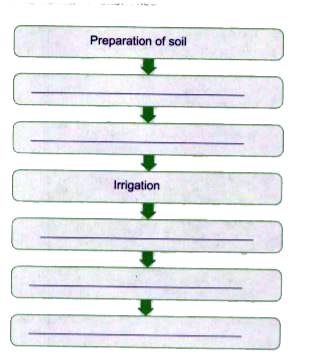What are basic practices of crop production?
Step-by-Step Text Solution
1. Preparation of Soil: The first basic practice in crop production is preparing the soil. This involves loosening the soil through a process called ploughing. Ploughing helps to aerate the soil, allowing air to mix with it and improving its quality.
2. Sowing Seeds: After the soil is prepared, the next step is to sow the seeds. One common method of sowing is called broadcasting, where farmers sprinkle seeds over the soil by hand to ensure they are sown evenly.
3. Adding Manure and Fertilizers: Once the seeds are sown, it is essential to enhance the soil's nutrient content. This is done by adding manure and fertilizers, which increase the nutrient value of the soil and promote healthy plant growth.
4. Irrigation: Proper irrigation is crucial for crop production. This step involves providing adequate water to the plants, as they cannot survive without it. Farmers must ensure that their crops receive sufficient water throughout their growth period.
5. Weed Control: Protecting crops from weeds is another important practice. Weeds are unwanted plants that compete with the crops for nutrients. Farmers need to remove these weeds to ensure that their crops receive the necessary nutrients for growth.
6. Harvesting: Once the crops have matured, the next step is harvesting. This involves cutting down the mature crops at the right time to ensure maximum yield.
7. Storage: After harvesting, the grains must be stored properly. This step is crucial for preserving the harvested crops until they can be sold in the market.
Topper's Solved these Questions
- BOOK - PEARSON IIT JEE FOUNDATIONCHAPTER - CROP PRODUCTION AND MANAGEMENT EXERCISE - TRACK YOUR LEARNING-I7videos
CROP PRODUCTION AND MANAGEMENT
- BOOK - PEARSON IIT JEE FOUNDATIONCHAPTER - CROP PRODUCTION AND MANAGEMENT EXERCISE - TRACK YOUR LEARNING-II8videos
CROP PRODUCTION AND MANAGEMENT
- BOOK - PEARSON IIT JEE FOUNDATIONCHAPTER - CONSERVATION OF PLANTS AND ANIMALSEXERCISE - COMPETITION CORNER43videos
CONSERVATION OF PLANTS AND ANIMALS
- BOOK - PEARSON IIT JEE FOUNDATIONCHAPTER - MICROORGANISMS - FRIEND AND FOEEXERCISE - COMPETITION CORNER50videos
MICROORGANISMS - FRIEND AND FOE
Similar Questions
What is crop production?
View SolutionA student lists the followin agricultural practices for crop production :
Irrigation , Removal of weeds , Preparation of soil , Storage of food grains , Sowing , Adding manure and fertilisers
Which agricultural practice is missing from the above list ?View Solution
Knowledge Check
- Question 1 - Select One
Which one of these is the first agriculture practice during crop production?
AAddition of pesticidesBPreparation of soilCHarvestingDIrrigation
Introduction|Agricultural Practices|Cropping Pattern|Basic Practices Of Crop Production |Preparation Of Soil|Process Of Ploughing|Agricultural Implements|OMR
View SolutionWhich factors influence the crop production?
View SolutionWhy is organic matter important for crop production?
View SolutionWhy is organic matter important for crop production?
View SolutionCrop production is a branch of agriculture that deals with growing crops for use as food and fiber. Principle of crop production of food in a manner that ensures the long-term productivity of the land, by protecting the health of soil, water, air and biodiversity. This can apply locally (in avoiding runoff to a nearby water-body), or globally.

(a) Complete the flow chart by listing the different agricultural practices followed by farmers, in the order in which they are implemented during crop production.
(b) What factors control crop production?
(c) What are the two types of crops that are grown in different seasons?
(d) Which crop is known as thirsty crop?View SolutionWhat are mycorrhiza? Give their importance in crop production.
View SolutionWhat are rabi crops ?
View Solution

